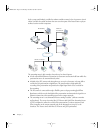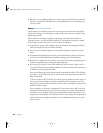Setup Example 63
Lower-end DV cameras use a single charge-coupled device (CCD) to capture the complete
image, whereas higher-quality cameras use three separate CCDs to scan the red, blue, and
green content of the image, giving a better quality scan. CCDs range in size from 1/4 inch
to 2/3 inch; bigger CCDs give better resolution.
Here are other desirable features:
m You should be able to override automatic camera settings.
m You’ll want to use a separate microphone that can plug into the camera for optimal sound
pick-up. A built-in microphone is unsuitable for most situations.
m The camera should accept professional XLR plugs (as opposed to the 1/8-inch mini-jack
connectors). It should also have a headphone jack for monitoring the audio input.
m Finally, a FireWire output enables digital transfers and automated capture, which can save
time later.
Keep the Microphone Close
The microphone is the first link in the audio signal chain and so is also very important.
Dynamic microphones are a good all-around choice and can be purchased for as little as
$100.
The best way to improve audio if the room is “bad” is to place the microphone as close as
possible to the person doing the speaking. Use a small lavalier (lapel) microphone clipped to
the front of the speaker’s clothing immediately under the mouth, or use a handheld
microphone.
In the case of a panel discussion, use multiple microphones, preferably on sturdy stands, and
a small audio mixer. Connect the mixed stereo output from the mixer into the line input on
the DV camera.
If using an external microphone or mixer, make sure that all the connectors are securely and
fully plugged in to assure reliable audio. Plug a pair of headphones into the video camera’s
headphone output to make sure that you can hear the audio at the video camera source and
that it’s not distorted.
A Tripod Is a Must
It’s important to use a camera tripod when shooting a live presentation, and also to avoid
pans, tilts, and zooms. If the camera moves just one degree, every pixel in the frame changes,
multiplying the difficulty of encoding the stream adequately. What was a simple scene to
encode suddenly becomes much more difficult.
The tripod should be lightweight while still providing stable support for the camera’s weight.
LL0329.book Page 63 Wednesday, November 20, 2002 2:09 PM


















